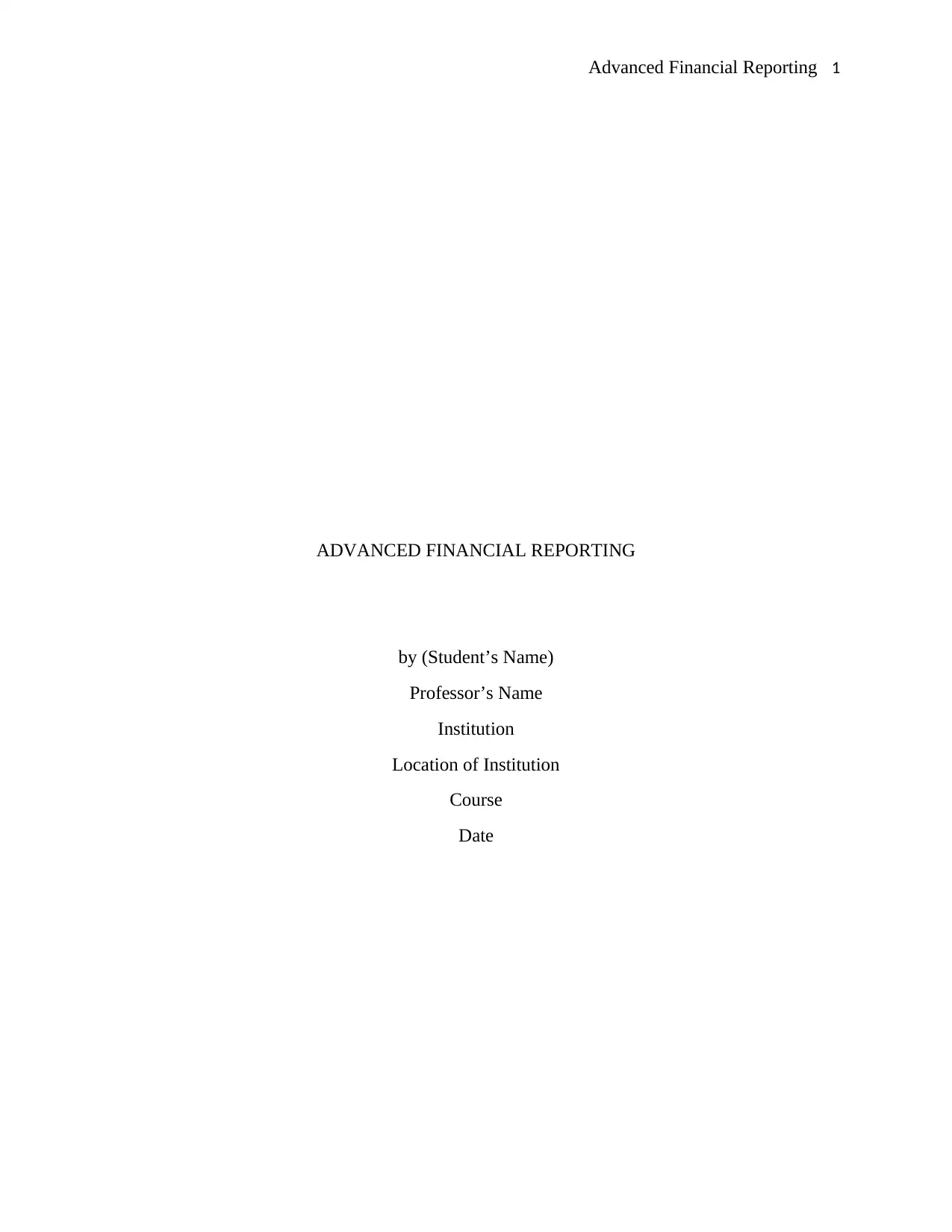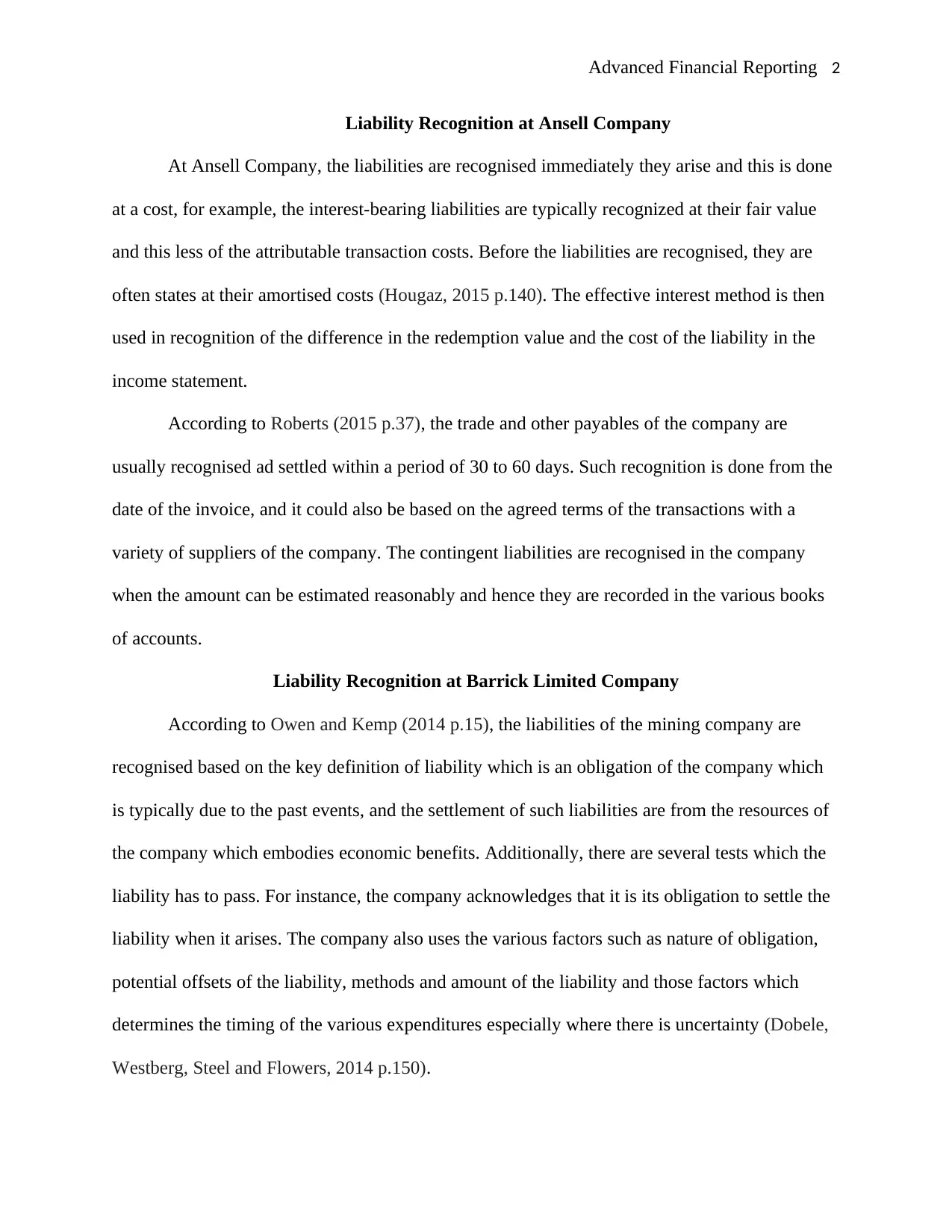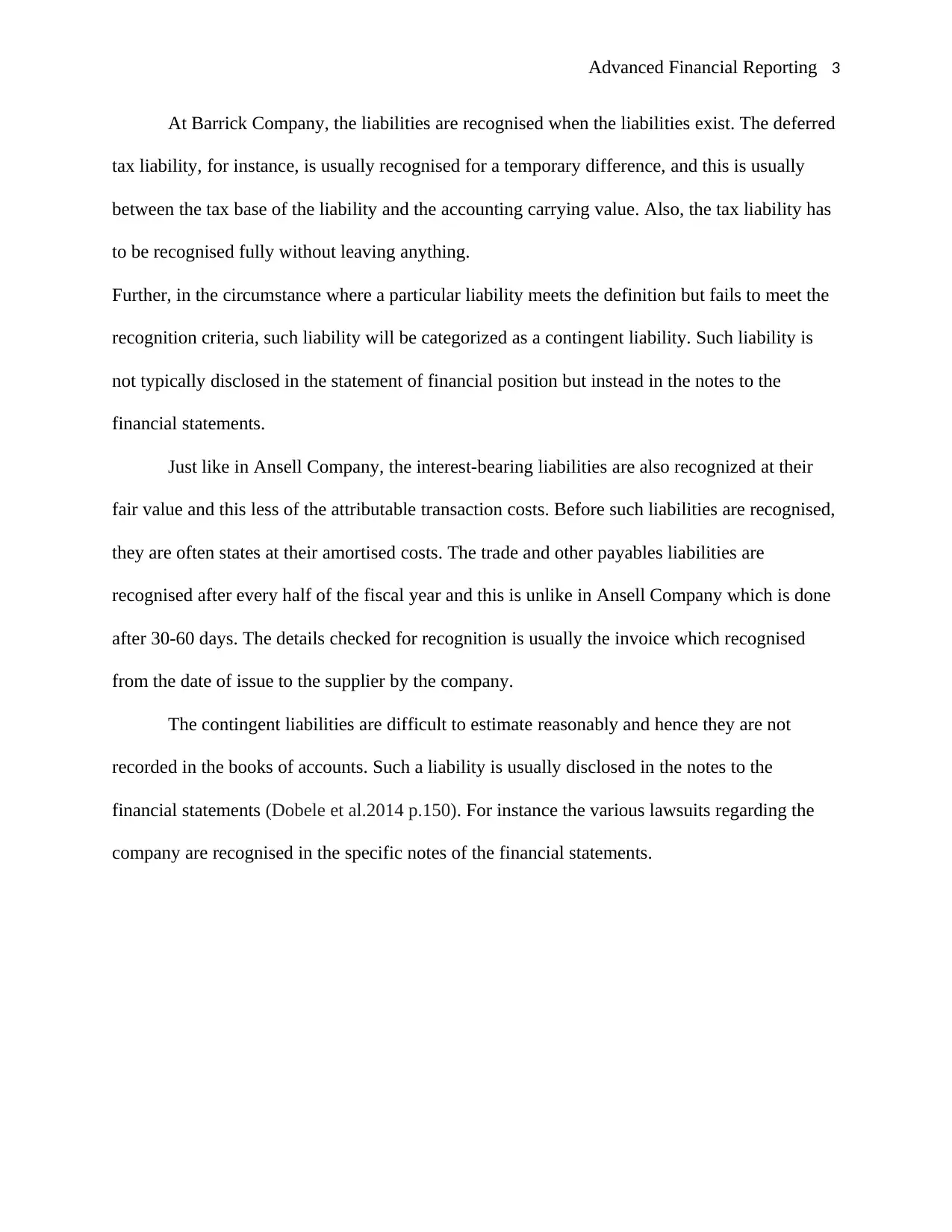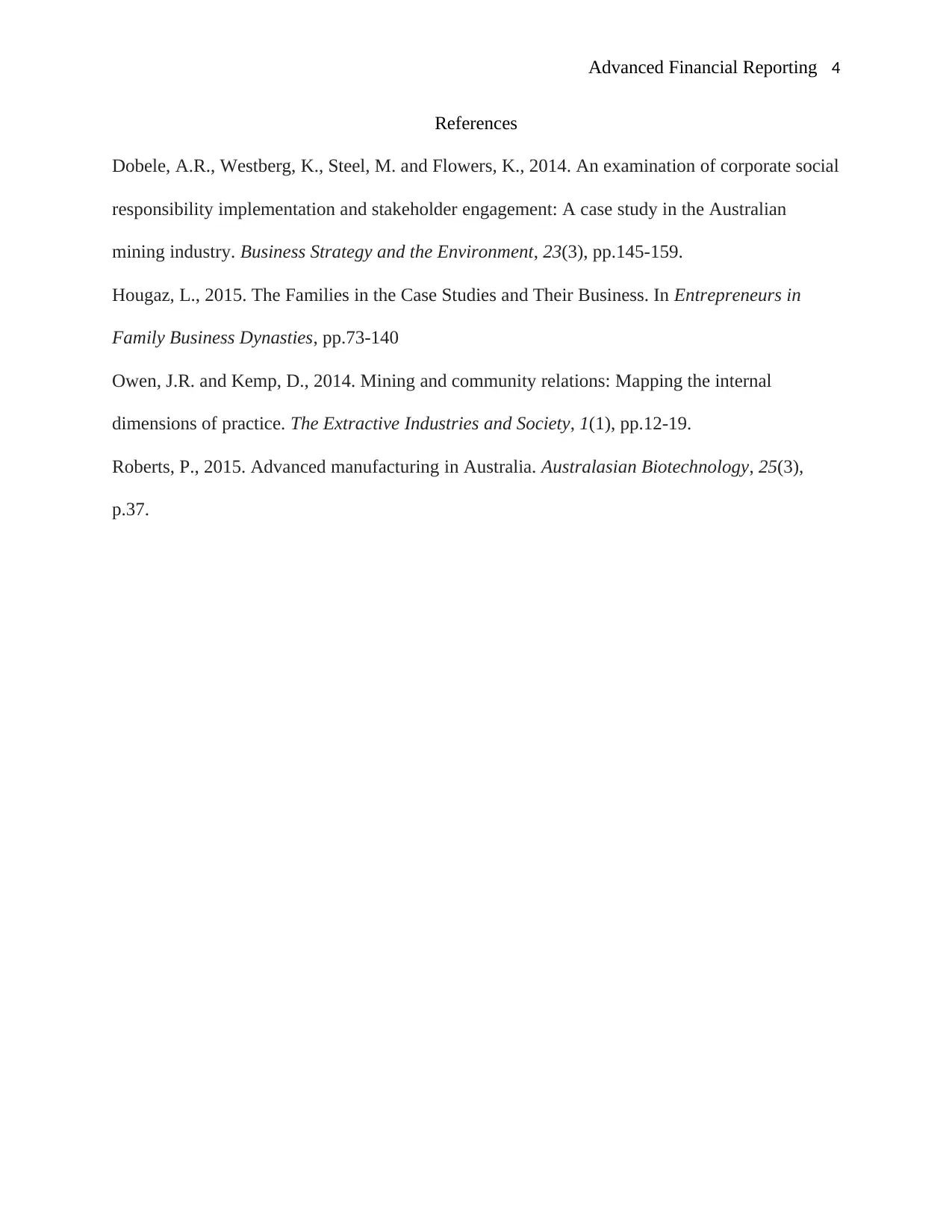Advanced Financial Reporting: Liability Recognition Differences Report
VerifiedAdded on 2023/06/07
|4
|766
|152
Report
AI Summary
This report provides a comparative analysis of liability recognition practices at Ansell Company (manufacturing) and Barrick Limited Company (mining), highlighting the differences in their approaches. It examines how each company recognizes liabilities, including interest-bearing liabilities, trade payables, and contingent liabilities, based on accounting standards and specific industry factors. The report details the timing of recognition, valuation methods, and disclosure practices, emphasizing the impact of estimation challenges and the role of notes to the financial statements in conveying relevant information. This document illustrates the nuances of financial reporting in different sectors and offers valuable insights into the practical application of accounting principles.

Advanced Financial Reporting 1
ADVANCED FINANCIAL REPORTING
by (Student’s Name)
Professor’s Name
Institution
Location of Institution
Course
Date
ADVANCED FINANCIAL REPORTING
by (Student’s Name)
Professor’s Name
Institution
Location of Institution
Course
Date
Paraphrase This Document
Need a fresh take? Get an instant paraphrase of this document with our AI Paraphraser

Advanced Financial Reporting 2
Liability Recognition at Ansell Company
At Ansell Company, the liabilities are recognised immediately they arise and this is done
at a cost, for example, the interest-bearing liabilities are typically recognized at their fair value
and this less of the attributable transaction costs. Before the liabilities are recognised, they are
often states at their amortised costs (Hougaz, 2015 p.140). The effective interest method is then
used in recognition of the difference in the redemption value and the cost of the liability in the
income statement.
According to Roberts (2015 p.37), the trade and other payables of the company are
usually recognised ad settled within a period of 30 to 60 days. Such recognition is done from the
date of the invoice, and it could also be based on the agreed terms of the transactions with a
variety of suppliers of the company. The contingent liabilities are recognised in the company
when the amount can be estimated reasonably and hence they are recorded in the various books
of accounts.
Liability Recognition at Barrick Limited Company
According to Owen and Kemp (2014 p.15), the liabilities of the mining company are
recognised based on the key definition of liability which is an obligation of the company which
is typically due to the past events, and the settlement of such liabilities are from the resources of
the company which embodies economic benefits. Additionally, there are several tests which the
liability has to pass. For instance, the company acknowledges that it is its obligation to settle the
liability when it arises. The company also uses the various factors such as nature of obligation,
potential offsets of the liability, methods and amount of the liability and those factors which
determines the timing of the various expenditures especially where there is uncertainty (Dobele,
Westberg, Steel and Flowers, 2014 p.150).
Liability Recognition at Ansell Company
At Ansell Company, the liabilities are recognised immediately they arise and this is done
at a cost, for example, the interest-bearing liabilities are typically recognized at their fair value
and this less of the attributable transaction costs. Before the liabilities are recognised, they are
often states at their amortised costs (Hougaz, 2015 p.140). The effective interest method is then
used in recognition of the difference in the redemption value and the cost of the liability in the
income statement.
According to Roberts (2015 p.37), the trade and other payables of the company are
usually recognised ad settled within a period of 30 to 60 days. Such recognition is done from the
date of the invoice, and it could also be based on the agreed terms of the transactions with a
variety of suppliers of the company. The contingent liabilities are recognised in the company
when the amount can be estimated reasonably and hence they are recorded in the various books
of accounts.
Liability Recognition at Barrick Limited Company
According to Owen and Kemp (2014 p.15), the liabilities of the mining company are
recognised based on the key definition of liability which is an obligation of the company which
is typically due to the past events, and the settlement of such liabilities are from the resources of
the company which embodies economic benefits. Additionally, there are several tests which the
liability has to pass. For instance, the company acknowledges that it is its obligation to settle the
liability when it arises. The company also uses the various factors such as nature of obligation,
potential offsets of the liability, methods and amount of the liability and those factors which
determines the timing of the various expenditures especially where there is uncertainty (Dobele,
Westberg, Steel and Flowers, 2014 p.150).

Advanced Financial Reporting 3
At Barrick Company, the liabilities are recognised when the liabilities exist. The deferred
tax liability, for instance, is usually recognised for a temporary difference, and this is usually
between the tax base of the liability and the accounting carrying value. Also, the tax liability has
to be recognised fully without leaving anything.
Further, in the circumstance where a particular liability meets the definition but fails to meet the
recognition criteria, such liability will be categorized as a contingent liability. Such liability is
not typically disclosed in the statement of financial position but instead in the notes to the
financial statements.
Just like in Ansell Company, the interest-bearing liabilities are also recognized at their
fair value and this less of the attributable transaction costs. Before such liabilities are recognised,
they are often states at their amortised costs. The trade and other payables liabilities are
recognised after every half of the fiscal year and this is unlike in Ansell Company which is done
after 30-60 days. The details checked for recognition is usually the invoice which recognised
from the date of issue to the supplier by the company.
The contingent liabilities are difficult to estimate reasonably and hence they are not
recorded in the books of accounts. Such a liability is usually disclosed in the notes to the
financial statements (Dobele et al.2014 p.150). For instance the various lawsuits regarding the
company are recognised in the specific notes of the financial statements.
At Barrick Company, the liabilities are recognised when the liabilities exist. The deferred
tax liability, for instance, is usually recognised for a temporary difference, and this is usually
between the tax base of the liability and the accounting carrying value. Also, the tax liability has
to be recognised fully without leaving anything.
Further, in the circumstance where a particular liability meets the definition but fails to meet the
recognition criteria, such liability will be categorized as a contingent liability. Such liability is
not typically disclosed in the statement of financial position but instead in the notes to the
financial statements.
Just like in Ansell Company, the interest-bearing liabilities are also recognized at their
fair value and this less of the attributable transaction costs. Before such liabilities are recognised,
they are often states at their amortised costs. The trade and other payables liabilities are
recognised after every half of the fiscal year and this is unlike in Ansell Company which is done
after 30-60 days. The details checked for recognition is usually the invoice which recognised
from the date of issue to the supplier by the company.
The contingent liabilities are difficult to estimate reasonably and hence they are not
recorded in the books of accounts. Such a liability is usually disclosed in the notes to the
financial statements (Dobele et al.2014 p.150). For instance the various lawsuits regarding the
company are recognised in the specific notes of the financial statements.
⊘ This is a preview!⊘
Do you want full access?
Subscribe today to unlock all pages.

Trusted by 1+ million students worldwide

Advanced Financial Reporting 4
References
Dobele, A.R., Westberg, K., Steel, M. and Flowers, K., 2014. An examination of corporate social
responsibility implementation and stakeholder engagement: A case study in the Australian
mining industry. Business Strategy and the Environment, 23(3), pp.145-159.
Hougaz, L., 2015. The Families in the Case Studies and Their Business. In Entrepreneurs in
Family Business Dynasties, pp.73-140
Owen, J.R. and Kemp, D., 2014. Mining and community relations: Mapping the internal
dimensions of practice. The Extractive Industries and Society, 1(1), pp.12-19.
Roberts, P., 2015. Advanced manufacturing in Australia. Australasian Biotechnology, 25(3),
p.37.
References
Dobele, A.R., Westberg, K., Steel, M. and Flowers, K., 2014. An examination of corporate social
responsibility implementation and stakeholder engagement: A case study in the Australian
mining industry. Business Strategy and the Environment, 23(3), pp.145-159.
Hougaz, L., 2015. The Families in the Case Studies and Their Business. In Entrepreneurs in
Family Business Dynasties, pp.73-140
Owen, J.R. and Kemp, D., 2014. Mining and community relations: Mapping the internal
dimensions of practice. The Extractive Industries and Society, 1(1), pp.12-19.
Roberts, P., 2015. Advanced manufacturing in Australia. Australasian Biotechnology, 25(3),
p.37.
1 out of 4
Related Documents
Your All-in-One AI-Powered Toolkit for Academic Success.
+13062052269
info@desklib.com
Available 24*7 on WhatsApp / Email
![[object Object]](/_next/static/media/star-bottom.7253800d.svg)
Unlock your academic potential
Copyright © 2020–2025 A2Z Services. All Rights Reserved. Developed and managed by ZUCOL.





